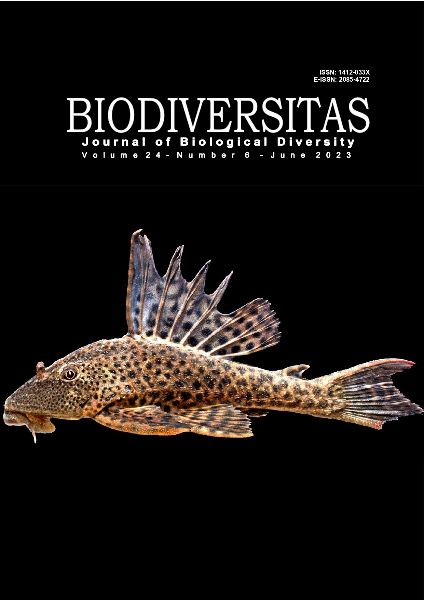Chemical composition, antioxidant, and antibacterial activity of Ruta graveolens (Rutaceae)
##plugins.themes.bootstrap3.article.main##
Abstract
Abstract. Saeed YS, Ali JF, Mohammed MA. 2023. Chemical composition, antioxidant, and antibacterial activity of Ruta graveolens (Rutaceae). Biodiversitas 24: 3162-3168. The present study was carried out to investigate the antioxidant and antibacterial activities of phenolic components isolated from the leaves of Ruta graveolens L. The phenolic compounds were extracted in different organic solvents (hexane, ethanol, and ethyl acetate) and analyzed by column chromatography, thin-layer chromatography, and high-performance liquid chromatography. Three discrete fractions were collected and subsequently examined: one from ethyl acetate extraction (I) and two from ethanolic extraction (II and III). No fractions from hexane were obtained. In particular, the ethanolic fractions were analyzed by HPLC analysis which contained the most bioactive compounds. The major phenolic compounds from the ethanol extracts were catechol and coumarin (1.104966 and 16.612227 mg/kg), followed by catechol and hydroquinone (0.144731 and 1.90781 mg/Kg), whereas, resorcinol and coumarin from the ethyl acetate extracts (14.78298 and 21.75253 mg/kg). The ethanol extract had the highest level of antioxidant activity, and other fractions had antioxidant effects at different levels; because the three fractions' phenolic chemicals have varied redox characteristics, their impacts vary in strength. The highest inhibition zones (mm) of Bacillus cereus and Staphylococcus aureus at 24 ?g/mL for fractions II and I were 23 and 22 mm, respectively. At 24 ?g/mL, Escherichia coli and Proteus vulgaris had inhibition zones of 21 and 20 mm, respectively. Fraction I and II did not show Escherichia coli and Proteus vulgaris inhibition zones (mm) at 1.5 µg/mL. Finally, the study's results suggest that using R. graveolens ethanol extracts may be a natural source of antioxidants and anti-infectious agents.
##plugins.themes.bootstrap3.article.details##
Most read articles by the same author(s)
- MOHAMMED ARAFAT MOHAMMED, JASSIM FATEHI ALI, YOUNIS SAADI SAEED, IBRAHIM HASSAN YASEEN, BUSHRA HABEEB AHMAD, Biological activity of some phenolic compounds extracted from Agrimonia eupatoria against several pathogenic bacteria species , Biodiversitas Journal of Biological Diversity: Vol. 23 No. 9 (2022)

